Digital Transformation and its Impact on Organizations' HRM
VerifiedAdded on 2022/06/08
|30
|8817
|28
Report
AI Summary
This white paper, prepared by Pranjali Galgali from Rutgers University, examines the profound impact of digital transformation on Human Resource Management (HRM) within organizations, framed through the lens of Stakeholder Theory. The paper explores how digitalization has revolutionized employee engagement and organizational communication, highlighting the roles of business leaders, HR teams, and employees in navigating technological, social, and behavioral changes. It focuses on internal communication tools such as email, intranet, and newsletters, while also addressing challenges and opportunities in stakeholder engagement. The paper delves into key terms like 'stakeholder' and 'organizational communication,' and discusses the evolution of leadership in the digital age. It emphasizes the importance of adapting to digital changes to reshape public image, foster value-based dialogues, and reinforce organizational objectives through effective HRM practices. The report also offers insights into industry best practices for recruitment, training, performance management, and employee engagement, with the aim of providing practical tools for business communication model changes. The paper further discusses the impact of digital disruption on traditional communication models, and emphasizes the need for agile strategies to engage both internal and external stakeholders. The paper also focuses on internal and external portals such as Glassdoor, LinkedIn, internal HRM sites, etc. that reshape the stakeholder relationships.
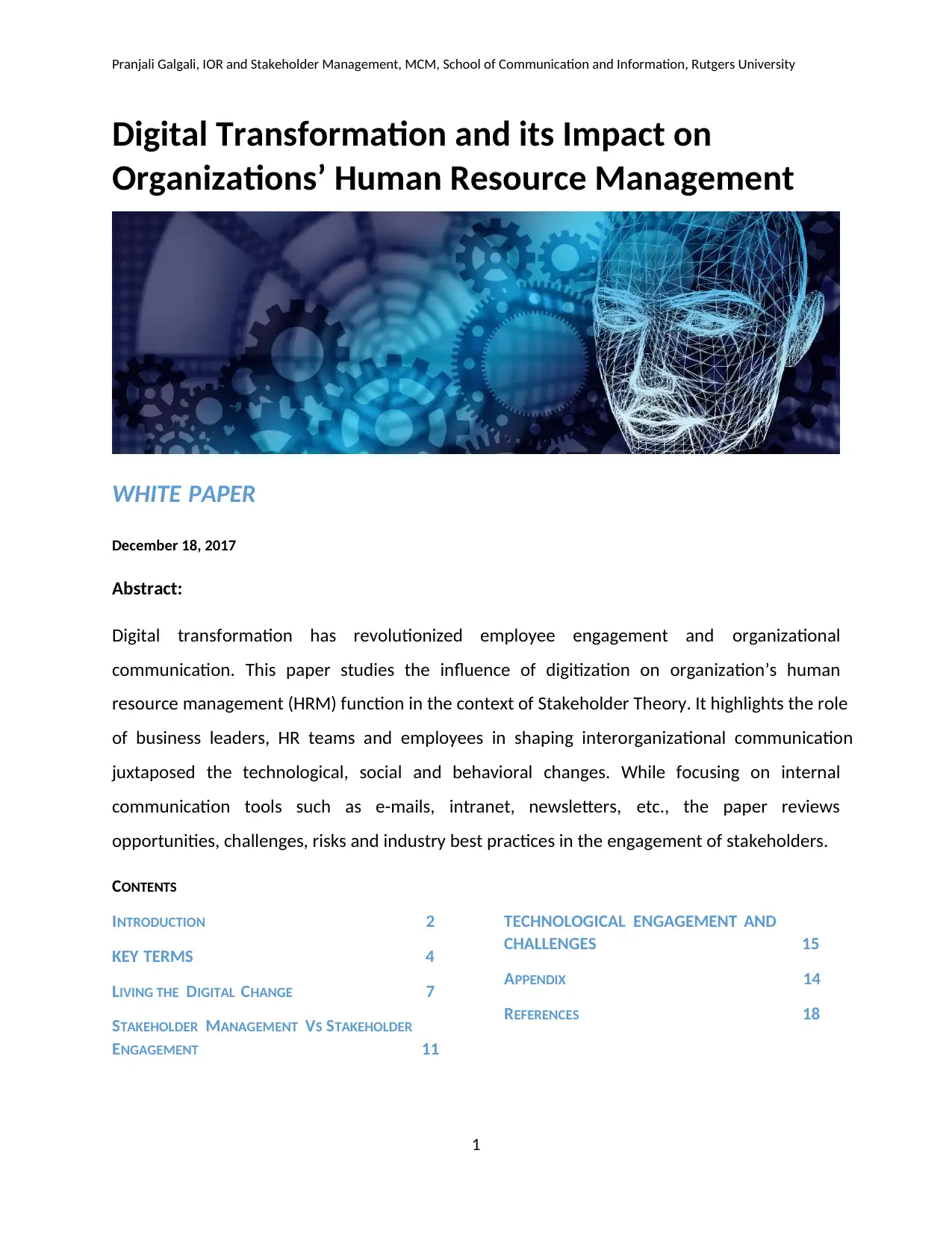
Pranjali Galgali, IOR and Stakeholder Management, MCM, School of Communication and Information, Rutgers University
1
Digital Transformation and its Impact on
Organizations’ Human Resource Management
WHITE PAPER
December 18, 2017
Abstract:
Digital transformation has revolutionized employee engagement and organizational
communication. This paper studies the influence of digitization on organization’s human
resource management (HRM) function in the context of Stakeholder Theory. It highlights the role
of business leaders, HR teams and employees in shaping interorganizational communication
juxtaposed the technological, social and behavioral changes. While focusing on internal
communication tools such as e-mails, intranet, newsletters, etc., the paper reviews
opportunities, challenges, risks and industry best practices in the engagement of stakeholders.
CONTENTS
INTRODUCTION 2
KEY TERMS 4
LIVING THE DIGITAL CHANGE 7
STAKEHOLDER MANAGEMENT VS STAKEHOLDER
ENGAGEMENT 11
TECHNOLOGICAL ENGAGEMENT AND
CHALLENGES 15
APPENDIX 14
REFERENCES 18
1
Digital Transformation and its Impact on
Organizations’ Human Resource Management
WHITE PAPER
December 18, 2017
Abstract:
Digital transformation has revolutionized employee engagement and organizational
communication. This paper studies the influence of digitization on organization’s human
resource management (HRM) function in the context of Stakeholder Theory. It highlights the role
of business leaders, HR teams and employees in shaping interorganizational communication
juxtaposed the technological, social and behavioral changes. While focusing on internal
communication tools such as e-mails, intranet, newsletters, etc., the paper reviews
opportunities, challenges, risks and industry best practices in the engagement of stakeholders.
CONTENTS
INTRODUCTION 2
KEY TERMS 4
LIVING THE DIGITAL CHANGE 7
STAKEHOLDER MANAGEMENT VS STAKEHOLDER
ENGAGEMENT 11
TECHNOLOGICAL ENGAGEMENT AND
CHALLENGES 15
APPENDIX 14
REFERENCES 18
Paraphrase This Document
Need a fresh take? Get an instant paraphrase of this document with our AI Paraphraser
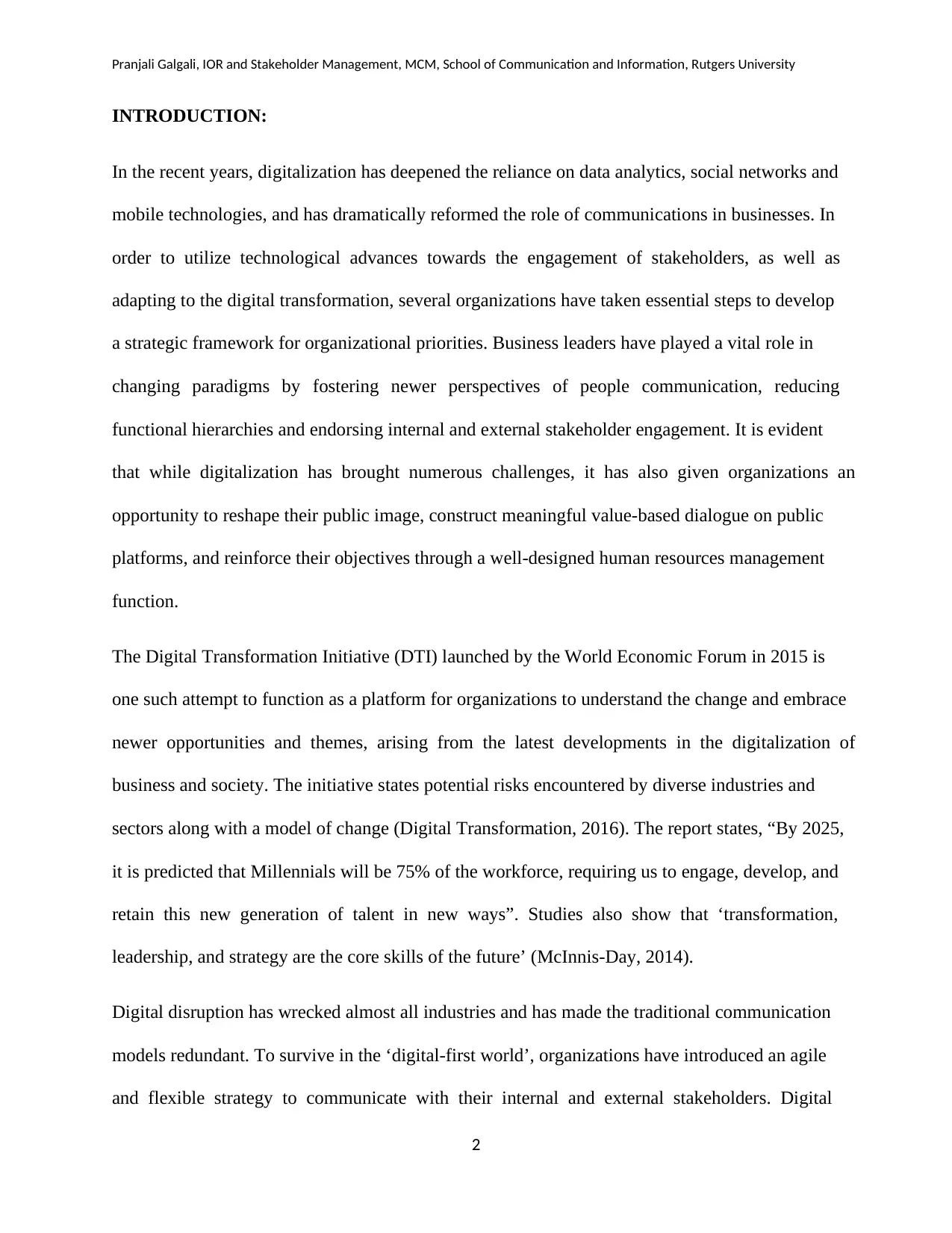
Pranjali Galgali, IOR and Stakeholder Management, MCM, School of Communication and Information, Rutgers University
2
INTRODUCTION:
In the recent years, digitalization has deepened the reliance on data analytics, social networks and
mobile technologies, and has dramatically reformed the role of communications in businesses. In
order to utilize technological advances towards the engagement of stakeholders, as well as
adapting to the digital transformation, several organizations have taken essential steps to develop
a strategic framework for organizational priorities. Business leaders have played a vital role in
changing paradigms by fostering newer perspectives of people communication, reducing
functional hierarchies and endorsing internal and external stakeholder engagement. It is evident
that while digitalization has brought numerous challenges, it has also given organizations an
opportunity to reshape their public image, construct meaningful value-based dialogue on public
platforms, and reinforce their objectives through a well-designed human resources management
function.
The Digital Transformation Initiative (DTI) launched by the World Economic Forum in 2015 is
one such attempt to function as a platform for organizations to understand the change and embrace
newer opportunities and themes, arising from the latest developments in the digitalization of
business and society. The initiative states potential risks encountered by diverse industries and
sectors along with a model of change (Digital Transformation, 2016). The report states, “By 2025,
it is predicted that Millennials will be 75% of the workforce, requiring us to engage, develop, and
retain this new generation of talent in new ways”. Studies also show that ‘transformation,
leadership, and strategy are the core skills of the future’ (McInnis-Day, 2014).
Digital disruption has wrecked almost all industries and has made the traditional communication
models redundant. To survive in the ‘digital-first world’, organizations have introduced an agile
and flexible strategy to communicate with their internal and external stakeholders. Digital
2
INTRODUCTION:
In the recent years, digitalization has deepened the reliance on data analytics, social networks and
mobile technologies, and has dramatically reformed the role of communications in businesses. In
order to utilize technological advances towards the engagement of stakeholders, as well as
adapting to the digital transformation, several organizations have taken essential steps to develop
a strategic framework for organizational priorities. Business leaders have played a vital role in
changing paradigms by fostering newer perspectives of people communication, reducing
functional hierarchies and endorsing internal and external stakeholder engagement. It is evident
that while digitalization has brought numerous challenges, it has also given organizations an
opportunity to reshape their public image, construct meaningful value-based dialogue on public
platforms, and reinforce their objectives through a well-designed human resources management
function.
The Digital Transformation Initiative (DTI) launched by the World Economic Forum in 2015 is
one such attempt to function as a platform for organizations to understand the change and embrace
newer opportunities and themes, arising from the latest developments in the digitalization of
business and society. The initiative states potential risks encountered by diverse industries and
sectors along with a model of change (Digital Transformation, 2016). The report states, “By 2025,
it is predicted that Millennials will be 75% of the workforce, requiring us to engage, develop, and
retain this new generation of talent in new ways”. Studies also show that ‘transformation,
leadership, and strategy are the core skills of the future’ (McInnis-Day, 2014).
Digital disruption has wrecked almost all industries and has made the traditional communication
models redundant. To survive in the ‘digital-first world’, organizations have introduced an agile
and flexible strategy to communicate with their internal and external stakeholders. Digital
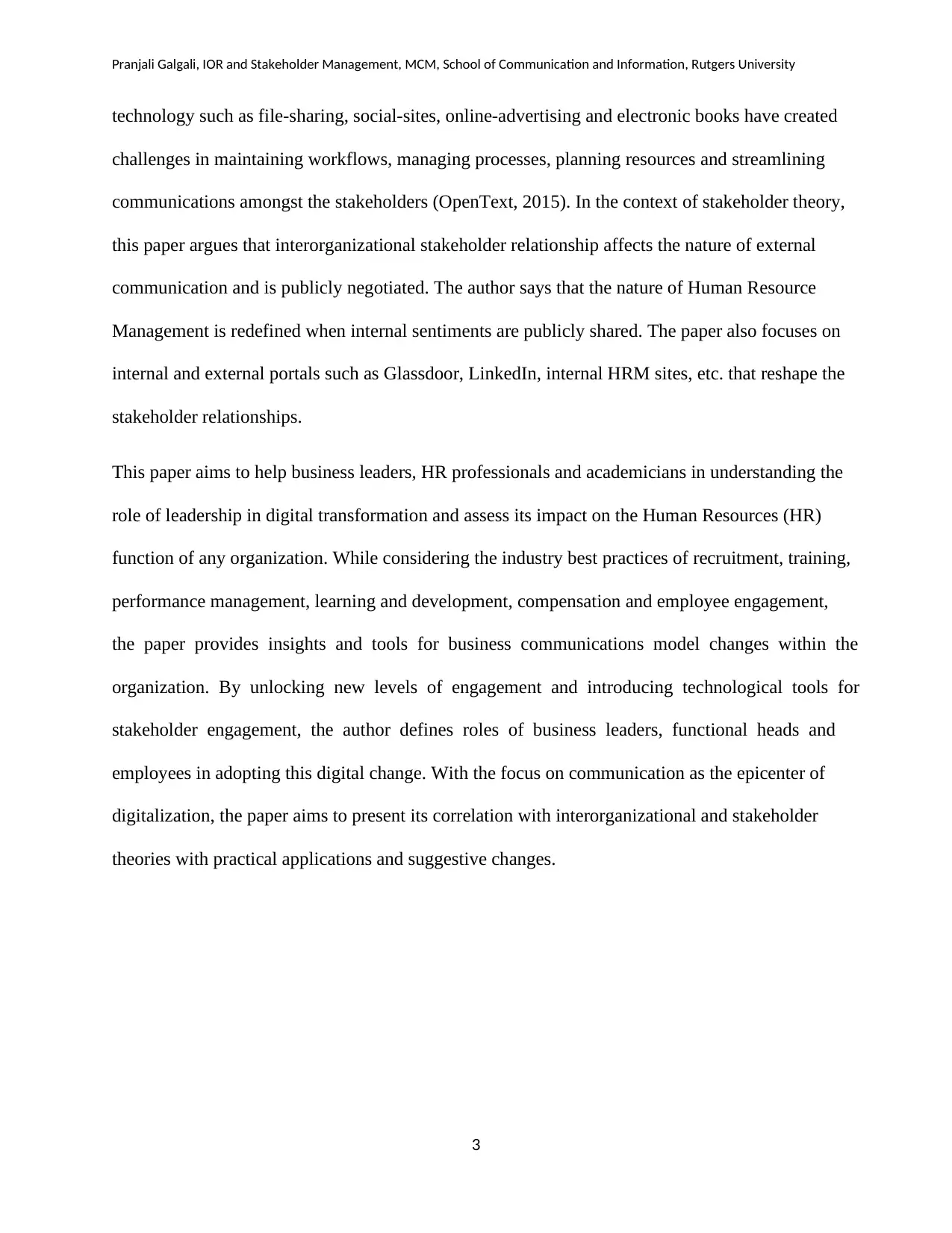
Pranjali Galgali, IOR and Stakeholder Management, MCM, School of Communication and Information, Rutgers University
3
technology such as file-sharing, social-sites, online-advertising and electronic books have created
challenges in maintaining workflows, managing processes, planning resources and streamlining
communications amongst the stakeholders (OpenText, 2015). In the context of stakeholder theory,
this paper argues that interorganizational stakeholder relationship affects the nature of external
communication and is publicly negotiated. The author says that the nature of Human Resource
Management is redefined when internal sentiments are publicly shared. The paper also focuses on
internal and external portals such as Glassdoor, LinkedIn, internal HRM sites, etc. that reshape the
stakeholder relationships.
This paper aims to help business leaders, HR professionals and academicians in understanding the
role of leadership in digital transformation and assess its impact on the Human Resources (HR)
function of any organization. While considering the industry best practices of recruitment, training,
performance management, learning and development, compensation and employee engagement,
the paper provides insights and tools for business communications model changes within the
organization. By unlocking new levels of engagement and introducing technological tools for
stakeholder engagement, the author defines roles of business leaders, functional heads and
employees in adopting this digital change. With the focus on communication as the epicenter of
digitalization, the paper aims to present its correlation with interorganizational and stakeholder
theories with practical applications and suggestive changes.
3
technology such as file-sharing, social-sites, online-advertising and electronic books have created
challenges in maintaining workflows, managing processes, planning resources and streamlining
communications amongst the stakeholders (OpenText, 2015). In the context of stakeholder theory,
this paper argues that interorganizational stakeholder relationship affects the nature of external
communication and is publicly negotiated. The author says that the nature of Human Resource
Management is redefined when internal sentiments are publicly shared. The paper also focuses on
internal and external portals such as Glassdoor, LinkedIn, internal HRM sites, etc. that reshape the
stakeholder relationships.
This paper aims to help business leaders, HR professionals and academicians in understanding the
role of leadership in digital transformation and assess its impact on the Human Resources (HR)
function of any organization. While considering the industry best practices of recruitment, training,
performance management, learning and development, compensation and employee engagement,
the paper provides insights and tools for business communications model changes within the
organization. By unlocking new levels of engagement and introducing technological tools for
stakeholder engagement, the author defines roles of business leaders, functional heads and
employees in adopting this digital change. With the focus on communication as the epicenter of
digitalization, the paper aims to present its correlation with interorganizational and stakeholder
theories with practical applications and suggestive changes.
⊘ This is a preview!⊘
Do you want full access?
Subscribe today to unlock all pages.

Trusted by 1+ million students worldwide
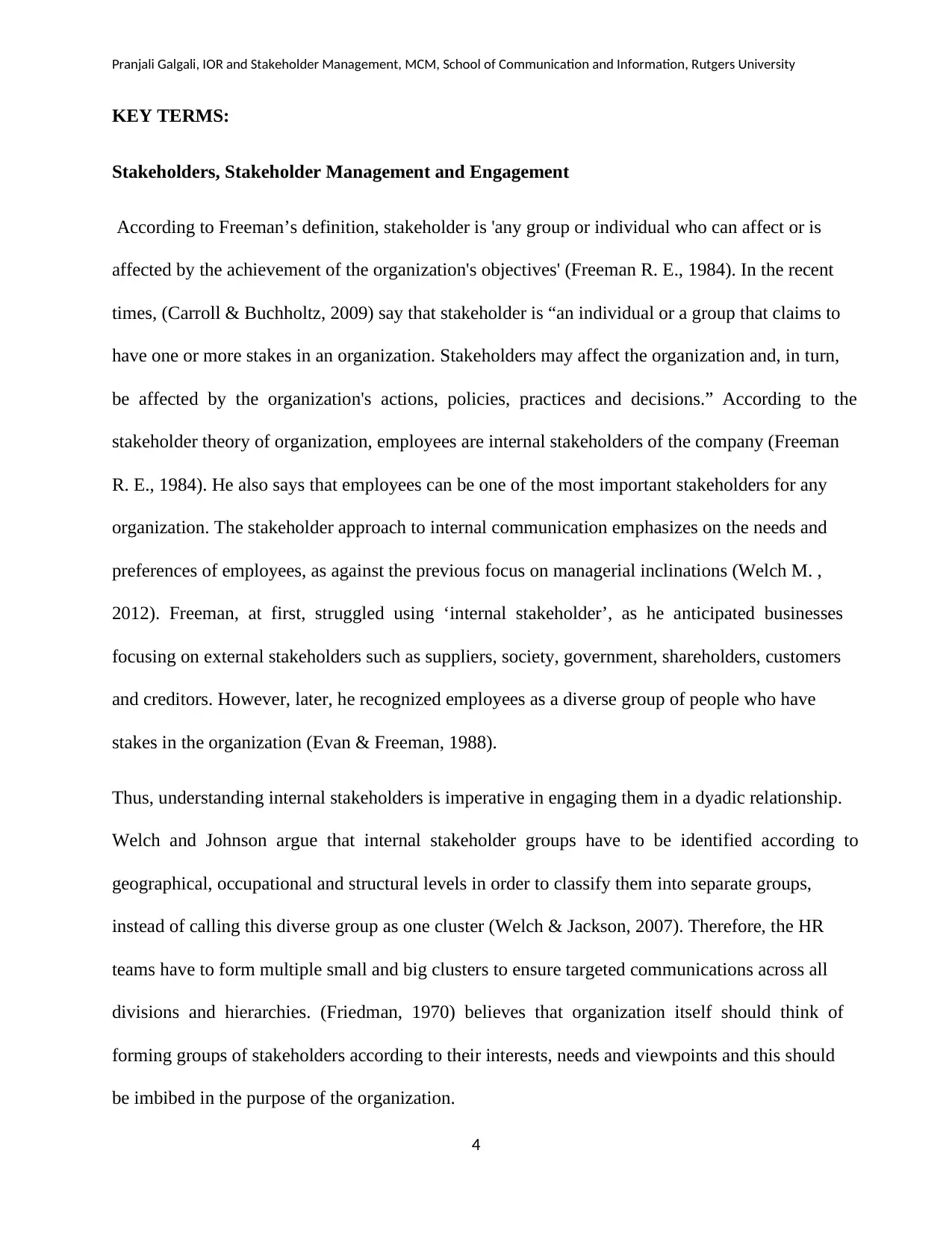
Pranjali Galgali, IOR and Stakeholder Management, MCM, School of Communication and Information, Rutgers University
4
KEY TERMS:
Stakeholders, Stakeholder Management and Engagement
According to Freeman’s definition, stakeholder is 'any group or individual who can affect or is
affected by the achievement of the organization's objectives' (Freeman R. E., 1984). In the recent
times, (Carroll & Buchholtz, 2009) say that stakeholder is “an individual or a group that claims to
have one or more stakes in an organization. Stakeholders may affect the organization and, in turn,
be affected by the organization's actions, policies, practices and decisions.” According to the
stakeholder theory of organization, employees are internal stakeholders of the company (Freeman
R. E., 1984). He also says that employees can be one of the most important stakeholders for any
organization. The stakeholder approach to internal communication emphasizes on the needs and
preferences of employees, as against the previous focus on managerial inclinations (Welch M. ,
2012). Freeman, at first, struggled using ‘internal stakeholder’, as he anticipated businesses
focusing on external stakeholders such as suppliers, society, government, shareholders, customers
and creditors. However, later, he recognized employees as a diverse group of people who have
stakes in the organization (Evan & Freeman, 1988).
Thus, understanding internal stakeholders is imperative in engaging them in a dyadic relationship.
Welch and Johnson argue that internal stakeholder groups have to be identified according to
geographical, occupational and structural levels in order to classify them into separate groups,
instead of calling this diverse group as one cluster (Welch & Jackson, 2007). Therefore, the HR
teams have to form multiple small and big clusters to ensure targeted communications across all
divisions and hierarchies. (Friedman, 1970) believes that organization itself should think of
forming groups of stakeholders according to their interests, needs and viewpoints and this should
be imbibed in the purpose of the organization.
4
KEY TERMS:
Stakeholders, Stakeholder Management and Engagement
According to Freeman’s definition, stakeholder is 'any group or individual who can affect or is
affected by the achievement of the organization's objectives' (Freeman R. E., 1984). In the recent
times, (Carroll & Buchholtz, 2009) say that stakeholder is “an individual or a group that claims to
have one or more stakes in an organization. Stakeholders may affect the organization and, in turn,
be affected by the organization's actions, policies, practices and decisions.” According to the
stakeholder theory of organization, employees are internal stakeholders of the company (Freeman
R. E., 1984). He also says that employees can be one of the most important stakeholders for any
organization. The stakeholder approach to internal communication emphasizes on the needs and
preferences of employees, as against the previous focus on managerial inclinations (Welch M. ,
2012). Freeman, at first, struggled using ‘internal stakeholder’, as he anticipated businesses
focusing on external stakeholders such as suppliers, society, government, shareholders, customers
and creditors. However, later, he recognized employees as a diverse group of people who have
stakes in the organization (Evan & Freeman, 1988).
Thus, understanding internal stakeholders is imperative in engaging them in a dyadic relationship.
Welch and Johnson argue that internal stakeholder groups have to be identified according to
geographical, occupational and structural levels in order to classify them into separate groups,
instead of calling this diverse group as one cluster (Welch & Jackson, 2007). Therefore, the HR
teams have to form multiple small and big clusters to ensure targeted communications across all
divisions and hierarchies. (Friedman, 1970) believes that organization itself should think of
forming groups of stakeholders according to their interests, needs and viewpoints and this should
be imbibed in the purpose of the organization.
Paraphrase This Document
Need a fresh take? Get an instant paraphrase of this document with our AI Paraphraser
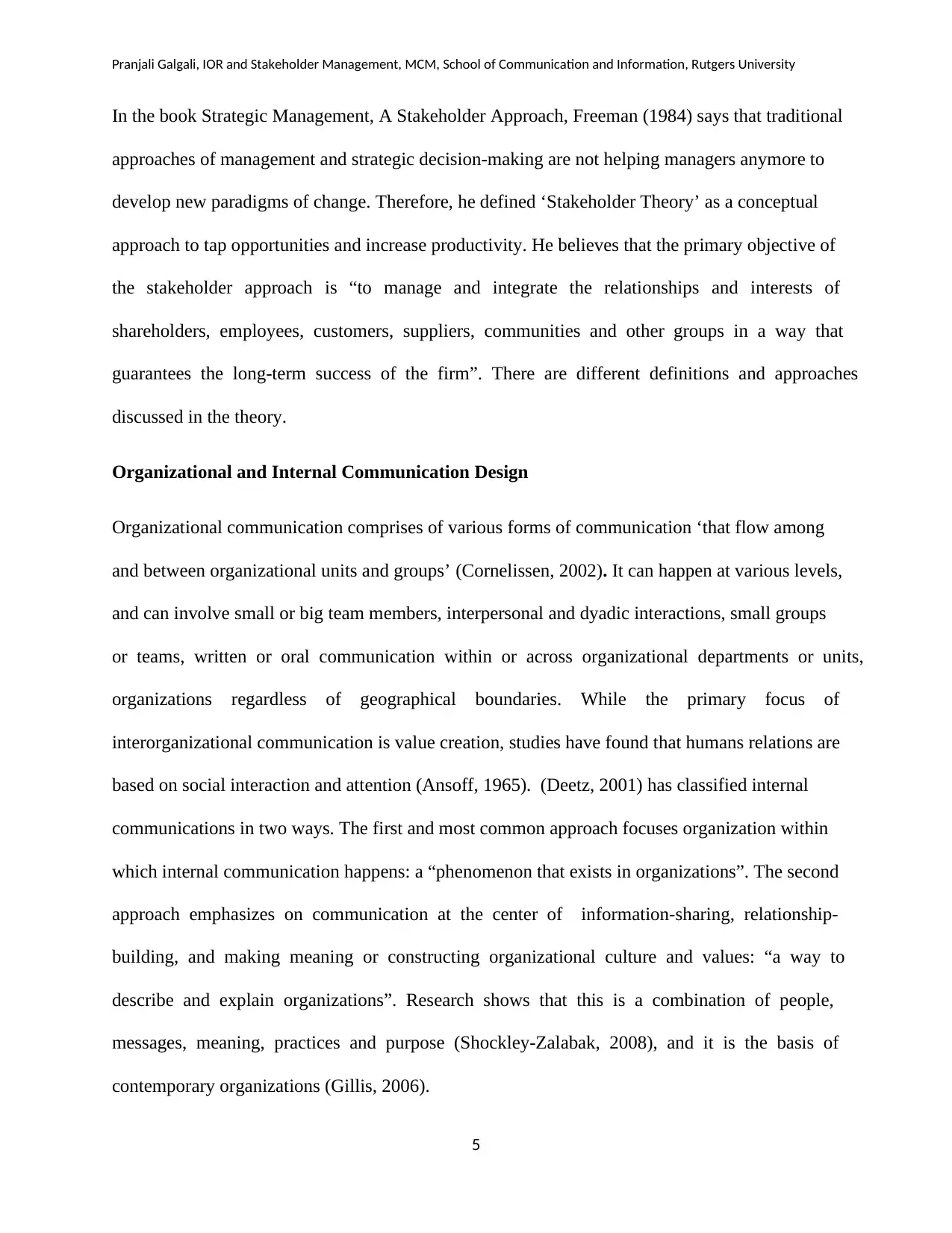
Pranjali Galgali, IOR and Stakeholder Management, MCM, School of Communication and Information, Rutgers University
5
In the book Strategic Management, A Stakeholder Approach, Freeman (1984) says that traditional
approaches of management and strategic decision-making are not helping managers anymore to
develop new paradigms of change. Therefore, he defined ‘Stakeholder Theory’ as a conceptual
approach to tap opportunities and increase productivity. He believes that the primary objective of
the stakeholder approach is “to manage and integrate the relationships and interests of
shareholders, employees, customers, suppliers, communities and other groups in a way that
guarantees the long-term success of the firm”. There are different definitions and approaches
discussed in the theory.
Organizational and Internal Communication Design
Organizational communication comprises of various forms of communication ‘that flow among
and between organizational units and groups’ (Cornelissen, 2002). It can happen at various levels,
and can involve small or big team members, interpersonal and dyadic interactions, small groups
or teams, written or oral communication within or across organizational departments or units,
organizations regardless of geographical boundaries. While the primary focus of
interorganizational communication is value creation, studies have found that humans relations are
based on social interaction and attention (Ansoff, 1965). (Deetz, 2001) has classified internal
communications in two ways. The first and most common approach focuses organization within
which internal communication happens: a “phenomenon that exists in organizations”. The second
approach emphasizes on communication at the center of information-sharing, relationship-
building, and making meaning or constructing organizational culture and values: “a way to
describe and explain organizations”. Research shows that this is a combination of people,
messages, meaning, practices and purpose (Shockley-Zalabak, 2008), and it is the basis of
contemporary organizations (Gillis, 2006).
5
In the book Strategic Management, A Stakeholder Approach, Freeman (1984) says that traditional
approaches of management and strategic decision-making are not helping managers anymore to
develop new paradigms of change. Therefore, he defined ‘Stakeholder Theory’ as a conceptual
approach to tap opportunities and increase productivity. He believes that the primary objective of
the stakeholder approach is “to manage and integrate the relationships and interests of
shareholders, employees, customers, suppliers, communities and other groups in a way that
guarantees the long-term success of the firm”. There are different definitions and approaches
discussed in the theory.
Organizational and Internal Communication Design
Organizational communication comprises of various forms of communication ‘that flow among
and between organizational units and groups’ (Cornelissen, 2002). It can happen at various levels,
and can involve small or big team members, interpersonal and dyadic interactions, small groups
or teams, written or oral communication within or across organizational departments or units,
organizations regardless of geographical boundaries. While the primary focus of
interorganizational communication is value creation, studies have found that humans relations are
based on social interaction and attention (Ansoff, 1965). (Deetz, 2001) has classified internal
communications in two ways. The first and most common approach focuses organization within
which internal communication happens: a “phenomenon that exists in organizations”. The second
approach emphasizes on communication at the center of information-sharing, relationship-
building, and making meaning or constructing organizational culture and values: “a way to
describe and explain organizations”. Research shows that this is a combination of people,
messages, meaning, practices and purpose (Shockley-Zalabak, 2008), and it is the basis of
contemporary organizations (Gillis, 2006).

Pranjali Galgali, IOR and Stakeholder Management, MCM, School of Communication and Information, Rutgers University
6
There are several networks and roles in organizational communication ‘such as gatekeepers (who
filter communication to a specific manager or upward through the organization), liaisons (who
mediate interaction between two groups), bridges (a group member who mediates interaction with
outside individuals), cosmopolite or boundary spanner (one who monitors the environment and
brings new information into the organization), cliques (members who communicate more with
each other than with other members), and grapevines and rumor networks (where members
communicate through informal and social networks about salient, time-sensitive topics)
(Trenholm, 2005) (Neher, 1997) (Miller, 1997).
Communication within these networks and roles can be managed by the HR teams in order to
facilitate vertical and horizontal communication. While vertical communication usually takes
place between managers and their subordinates, horizontal communication is the exchange of
messages between the same hierarchy. According to (Cornelissen, 2002), there are two parts of
vertical communication: “Upward communication consists of messages from subordinates to
superiors, whilst downward communication occurs when information flows down the hierarchy
from superiors to subordinates”.
According to the Institute of Public Relations, internal communications is an important
communication tool to build trust, motivate employees, create a shared identity and build
engagement besides providing important information about the work, organization, environment
and each other. It is one of the important platforms that help employees express their voice, share
opinions, celebrate and remember accomplishments. Lastly, the study of Interorganizational
communication is an overarching term used to study a wide gamut of entities and organizing acts
that comprise of several relationships.
6
There are several networks and roles in organizational communication ‘such as gatekeepers (who
filter communication to a specific manager or upward through the organization), liaisons (who
mediate interaction between two groups), bridges (a group member who mediates interaction with
outside individuals), cosmopolite or boundary spanner (one who monitors the environment and
brings new information into the organization), cliques (members who communicate more with
each other than with other members), and grapevines and rumor networks (where members
communicate through informal and social networks about salient, time-sensitive topics)
(Trenholm, 2005) (Neher, 1997) (Miller, 1997).
Communication within these networks and roles can be managed by the HR teams in order to
facilitate vertical and horizontal communication. While vertical communication usually takes
place between managers and their subordinates, horizontal communication is the exchange of
messages between the same hierarchy. According to (Cornelissen, 2002), there are two parts of
vertical communication: “Upward communication consists of messages from subordinates to
superiors, whilst downward communication occurs when information flows down the hierarchy
from superiors to subordinates”.
According to the Institute of Public Relations, internal communications is an important
communication tool to build trust, motivate employees, create a shared identity and build
engagement besides providing important information about the work, organization, environment
and each other. It is one of the important platforms that help employees express their voice, share
opinions, celebrate and remember accomplishments. Lastly, the study of Interorganizational
communication is an overarching term used to study a wide gamut of entities and organizing acts
that comprise of several relationships.
⊘ This is a preview!⊘
Do you want full access?
Subscribe today to unlock all pages.

Trusted by 1+ million students worldwide
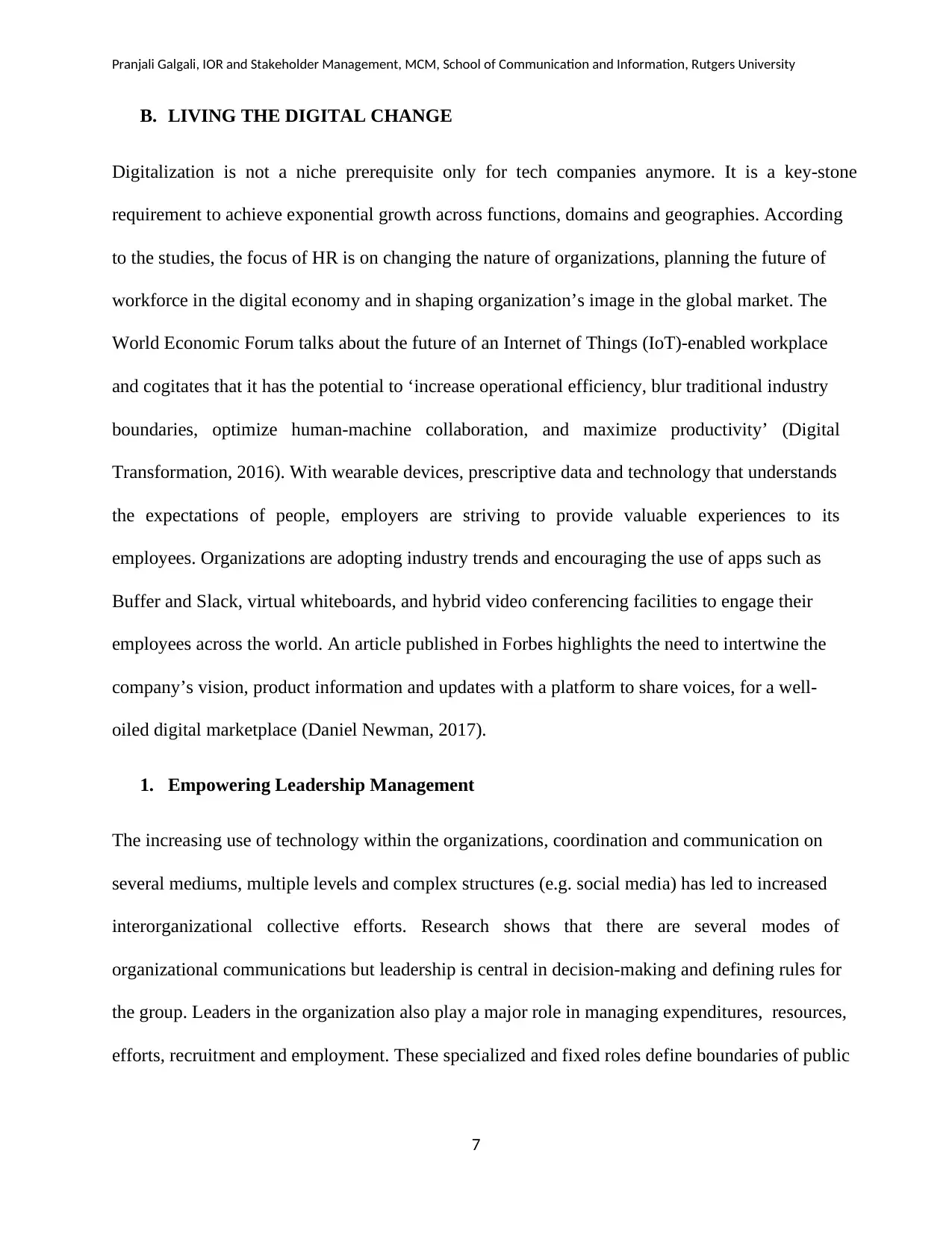
Pranjali Galgali, IOR and Stakeholder Management, MCM, School of Communication and Information, Rutgers University
7
B. LIVING THE DIGITAL CHANGE
Digitalization is not a niche prerequisite only for tech companies anymore. It is a key-stone
requirement to achieve exponential growth across functions, domains and geographies. According
to the studies, the focus of HR is on changing the nature of organizations, planning the future of
workforce in the digital economy and in shaping organization’s image in the global market. The
World Economic Forum talks about the future of an Internet of Things (IoT)-enabled workplace
and cogitates that it has the potential to ‘increase operational efficiency, blur traditional industry
boundaries, optimize human-machine collaboration, and maximize productivity’ (Digital
Transformation, 2016). With wearable devices, prescriptive data and technology that understands
the expectations of people, employers are striving to provide valuable experiences to its
employees. Organizations are adopting industry trends and encouraging the use of apps such as
Buffer and Slack, virtual whiteboards, and hybrid video conferencing facilities to engage their
employees across the world. An article published in Forbes highlights the need to intertwine the
company’s vision, product information and updates with a platform to share voices, for a well-
oiled digital marketplace (Daniel Newman, 2017).
1. Empowering Leadership Management
The increasing use of technology within the organizations, coordination and communication on
several mediums, multiple levels and complex structures (e.g. social media) has led to increased
interorganizational collective efforts. Research shows that there are several modes of
organizational communications but leadership is central in decision-making and defining rules for
the group. Leaders in the organization also play a major role in managing expenditures, resources,
efforts, recruitment and employment. These specialized and fixed roles define boundaries of public
7
B. LIVING THE DIGITAL CHANGE
Digitalization is not a niche prerequisite only for tech companies anymore. It is a key-stone
requirement to achieve exponential growth across functions, domains and geographies. According
to the studies, the focus of HR is on changing the nature of organizations, planning the future of
workforce in the digital economy and in shaping organization’s image in the global market. The
World Economic Forum talks about the future of an Internet of Things (IoT)-enabled workplace
and cogitates that it has the potential to ‘increase operational efficiency, blur traditional industry
boundaries, optimize human-machine collaboration, and maximize productivity’ (Digital
Transformation, 2016). With wearable devices, prescriptive data and technology that understands
the expectations of people, employers are striving to provide valuable experiences to its
employees. Organizations are adopting industry trends and encouraging the use of apps such as
Buffer and Slack, virtual whiteboards, and hybrid video conferencing facilities to engage their
employees across the world. An article published in Forbes highlights the need to intertwine the
company’s vision, product information and updates with a platform to share voices, for a well-
oiled digital marketplace (Daniel Newman, 2017).
1. Empowering Leadership Management
The increasing use of technology within the organizations, coordination and communication on
several mediums, multiple levels and complex structures (e.g. social media) has led to increased
interorganizational collective efforts. Research shows that there are several modes of
organizational communications but leadership is central in decision-making and defining rules for
the group. Leaders in the organization also play a major role in managing expenditures, resources,
efforts, recruitment and employment. These specialized and fixed roles define boundaries of public
Paraphrase This Document
Need a fresh take? Get an instant paraphrase of this document with our AI Paraphraser
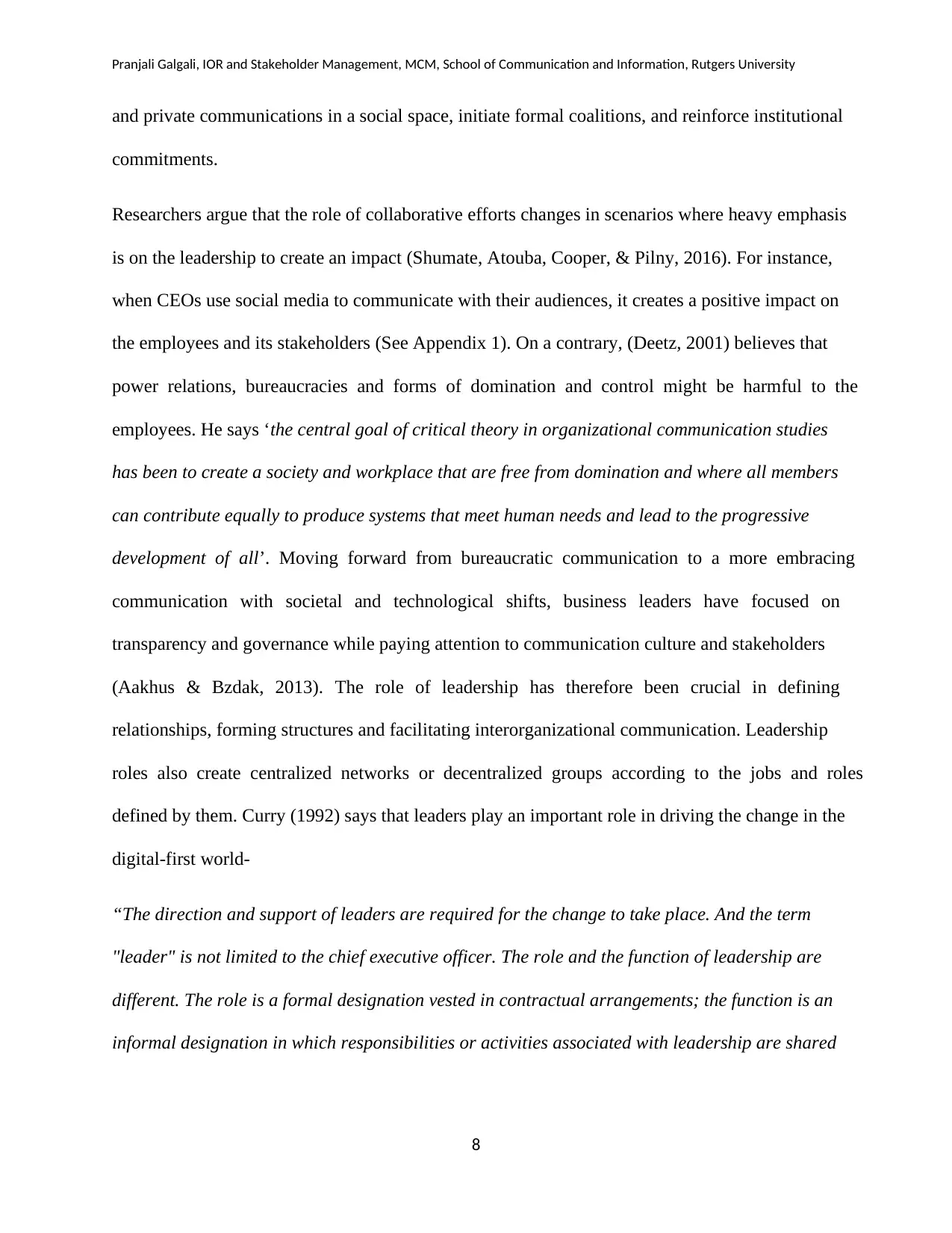
Pranjali Galgali, IOR and Stakeholder Management, MCM, School of Communication and Information, Rutgers University
8
and private communications in a social space, initiate formal coalitions, and reinforce institutional
commitments.
Researchers argue that the role of collaborative efforts changes in scenarios where heavy emphasis
is on the leadership to create an impact (Shumate, Atouba, Cooper, & Pilny, 2016). For instance,
when CEOs use social media to communicate with their audiences, it creates a positive impact on
the employees and its stakeholders (See Appendix 1). On a contrary, (Deetz, 2001) believes that
power relations, bureaucracies and forms of domination and control might be harmful to the
employees. He says ‘the central goal of critical theory in organizational communication studies
has been to create a society and workplace that are free from domination and where all members
can contribute equally to produce systems that meet human needs and lead to the progressive
development of all’. Moving forward from bureaucratic communication to a more embracing
communication with societal and technological shifts, business leaders have focused on
transparency and governance while paying attention to communication culture and stakeholders
(Aakhus & Bzdak, 2013). The role of leadership has therefore been crucial in defining
relationships, forming structures and facilitating interorganizational communication. Leadership
roles also create centralized networks or decentralized groups according to the jobs and roles
defined by them. Curry (1992) says that leaders play an important role in driving the change in the
digital-first world-
“The direction and support of leaders are required for the change to take place. And the term
"leader" is not limited to the chief executive officer. The role and the function of leadership are
different. The role is a formal designation vested in contractual arrangements; the function is an
informal designation in which responsibilities or activities associated with leadership are shared
8
and private communications in a social space, initiate formal coalitions, and reinforce institutional
commitments.
Researchers argue that the role of collaborative efforts changes in scenarios where heavy emphasis
is on the leadership to create an impact (Shumate, Atouba, Cooper, & Pilny, 2016). For instance,
when CEOs use social media to communicate with their audiences, it creates a positive impact on
the employees and its stakeholders (See Appendix 1). On a contrary, (Deetz, 2001) believes that
power relations, bureaucracies and forms of domination and control might be harmful to the
employees. He says ‘the central goal of critical theory in organizational communication studies
has been to create a society and workplace that are free from domination and where all members
can contribute equally to produce systems that meet human needs and lead to the progressive
development of all’. Moving forward from bureaucratic communication to a more embracing
communication with societal and technological shifts, business leaders have focused on
transparency and governance while paying attention to communication culture and stakeholders
(Aakhus & Bzdak, 2013). The role of leadership has therefore been crucial in defining
relationships, forming structures and facilitating interorganizational communication. Leadership
roles also create centralized networks or decentralized groups according to the jobs and roles
defined by them. Curry (1992) says that leaders play an important role in driving the change in the
digital-first world-
“The direction and support of leaders are required for the change to take place. And the term
"leader" is not limited to the chief executive officer. The role and the function of leadership are
different. The role is a formal designation vested in contractual arrangements; the function is an
informal designation in which responsibilities or activities associated with leadership are shared

Pranjali Galgali, IOR and Stakeholder Management, MCM, School of Communication and Information, Rutgers University
9
among members of the organization. Consequently, "leader" might refer to a number of individuals
participating in the change process.”
2. Changing Organizational Environment
Research shows that interorganizational communication relies on structures, forms, and processes
of relationships which in turn rely on information communication technology (ICT), mainly to
collaborate relationships, manage communication flow and define structures within the
organization. Leaders concretize these linkages, form robust networks and usher information
sharing to form interdependencies that are related to resources, staff and outcomes (Deetz, 2001).
The role of communication and technology also depends on the factors such as culture, political
and ideological views, anonymity and secrecy, the size, legal status and dynamics around the
nature of the organization (Scott C. , 2013). Similarly, (Pfeffer & Salancik, 1978) (Shumate,
Atouba, Cooper, & Pilny, 2016) discuss that organizations must exchange resources and reduce
the dependency on external factors to survive in any environment. According to a (Deloitte, 2016)
study, the changing needs of HR heavily rely on the following disruptive themes:
• Digital megatrends, including but not limited to, cyber, data, cloud, social and mobile
• A multi-generational workforce including millennials or first-generation digital citizens
• Merging work and life with hyper-connected employees
• Emergence of a new set of digitally skilled employees
• Business models under stress from digital disruption
• The employee being perceived as the first consumer of the employer’s brand
With this transformation, the HR leaders should be able to quickly adapt to the industry trends,
provide training to the existing employees and hire the right candidates into the dynamic digital
9
among members of the organization. Consequently, "leader" might refer to a number of individuals
participating in the change process.”
2. Changing Organizational Environment
Research shows that interorganizational communication relies on structures, forms, and processes
of relationships which in turn rely on information communication technology (ICT), mainly to
collaborate relationships, manage communication flow and define structures within the
organization. Leaders concretize these linkages, form robust networks and usher information
sharing to form interdependencies that are related to resources, staff and outcomes (Deetz, 2001).
The role of communication and technology also depends on the factors such as culture, political
and ideological views, anonymity and secrecy, the size, legal status and dynamics around the
nature of the organization (Scott C. , 2013). Similarly, (Pfeffer & Salancik, 1978) (Shumate,
Atouba, Cooper, & Pilny, 2016) discuss that organizations must exchange resources and reduce
the dependency on external factors to survive in any environment. According to a (Deloitte, 2016)
study, the changing needs of HR heavily rely on the following disruptive themes:
• Digital megatrends, including but not limited to, cyber, data, cloud, social and mobile
• A multi-generational workforce including millennials or first-generation digital citizens
• Merging work and life with hyper-connected employees
• Emergence of a new set of digitally skilled employees
• Business models under stress from digital disruption
• The employee being perceived as the first consumer of the employer’s brand
With this transformation, the HR leaders should be able to quickly adapt to the industry trends,
provide training to the existing employees and hire the right candidates into the dynamic digital
⊘ This is a preview!⊘
Do you want full access?
Subscribe today to unlock all pages.

Trusted by 1+ million students worldwide
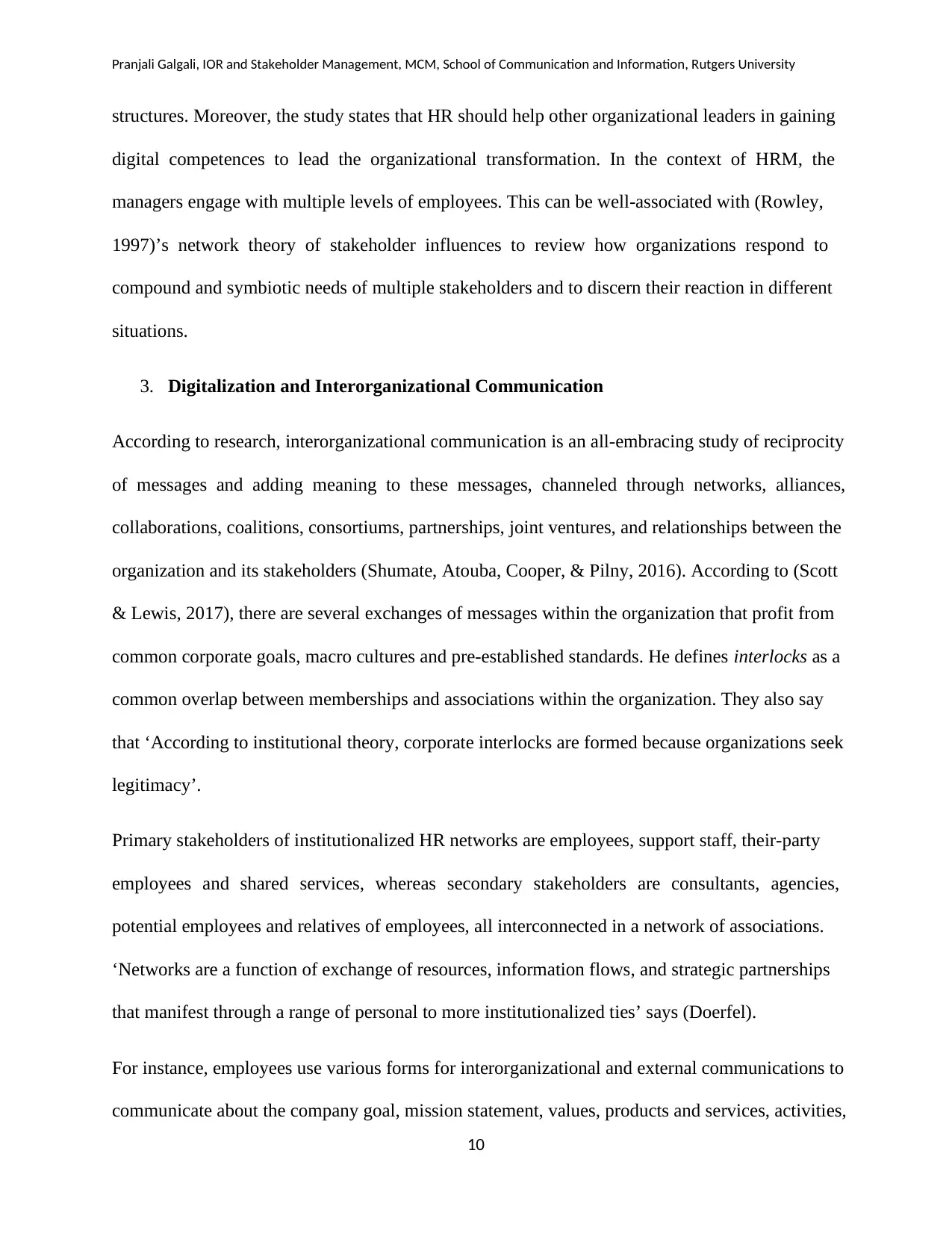
Pranjali Galgali, IOR and Stakeholder Management, MCM, School of Communication and Information, Rutgers University
10
structures. Moreover, the study states that HR should help other organizational leaders in gaining
digital competences to lead the organizational transformation. In the context of HRM, the
managers engage with multiple levels of employees. This can be well-associated with (Rowley,
1997)’s network theory of stakeholder influences to review how organizations respond to
compound and symbiotic needs of multiple stakeholders and to discern their reaction in different
situations.
3. Digitalization and Interorganizational Communication
According to research, interorganizational communication is an all-embracing study of reciprocity
of messages and adding meaning to these messages, channeled through networks, alliances,
collaborations, coalitions, consortiums, partnerships, joint ventures, and relationships between the
organization and its stakeholders (Shumate, Atouba, Cooper, & Pilny, 2016). According to (Scott
& Lewis, 2017), there are several exchanges of messages within the organization that profit from
common corporate goals, macro cultures and pre-established standards. He defines interlocks as a
common overlap between memberships and associations within the organization. They also say
that ‘According to institutional theory, corporate interlocks are formed because organizations seek
legitimacy’.
Primary stakeholders of institutionalized HR networks are employees, support staff, their-party
employees and shared services, whereas secondary stakeholders are consultants, agencies,
potential employees and relatives of employees, all interconnected in a network of associations.
‘Networks are a function of exchange of resources, information flows, and strategic partnerships
that manifest through a range of personal to more institutionalized ties’ says (Doerfel).
For instance, employees use various forms for interorganizational and external communications to
communicate about the company goal, mission statement, values, products and services, activities,
10
structures. Moreover, the study states that HR should help other organizational leaders in gaining
digital competences to lead the organizational transformation. In the context of HRM, the
managers engage with multiple levels of employees. This can be well-associated with (Rowley,
1997)’s network theory of stakeholder influences to review how organizations respond to
compound and symbiotic needs of multiple stakeholders and to discern their reaction in different
situations.
3. Digitalization and Interorganizational Communication
According to research, interorganizational communication is an all-embracing study of reciprocity
of messages and adding meaning to these messages, channeled through networks, alliances,
collaborations, coalitions, consortiums, partnerships, joint ventures, and relationships between the
organization and its stakeholders (Shumate, Atouba, Cooper, & Pilny, 2016). According to (Scott
& Lewis, 2017), there are several exchanges of messages within the organization that profit from
common corporate goals, macro cultures and pre-established standards. He defines interlocks as a
common overlap between memberships and associations within the organization. They also say
that ‘According to institutional theory, corporate interlocks are formed because organizations seek
legitimacy’.
Primary stakeholders of institutionalized HR networks are employees, support staff, their-party
employees and shared services, whereas secondary stakeholders are consultants, agencies,
potential employees and relatives of employees, all interconnected in a network of associations.
‘Networks are a function of exchange of resources, information flows, and strategic partnerships
that manifest through a range of personal to more institutionalized ties’ says (Doerfel).
For instance, employees use various forms for interorganizational and external communications to
communicate about the company goal, mission statement, values, products and services, activities,
Paraphrase This Document
Need a fresh take? Get an instant paraphrase of this document with our AI Paraphraser

Pranjali Galgali, IOR and Stakeholder Management, MCM, School of Communication and Information, Rutgers University
11
financial reporting, etc., which in turn adds value to the overall brand. This also makes the
organization more accountable as compared to others who don’t communicate using various
platforms. According to the study (see Appendix 2), 55% of the consumers believed that social
media helps employees share experiences and the ways in which they found the organization to be
more accountable in the consumer market.
Research shows that individuals who follow the institutional rules tend to reproduce messages
aligned to the institution’s propositions. (DiMaggio & Powell, 1983) in their study report that, ‘as
organizational leaders, managers, and employees adopt and follow institutional rules, their
organizations become more similar to each other’. This boundary-spanning interorganizational
communication can be found across organizations, which in turn leads to organizational change
and decision-making (McPhee & Zaug, 2012). (Lammers & Barbour, 2006) find that formal
knowledge, rationality and independence are key factors of institutional theory of organizational
communication that offer powerful guides of behavior. Using technology in Human Resource
Management can be one of the powerful tools that can institutionalize organizations, identify
cultural and societal blocks and offer real-time solutions to societal, behavioral and sociological
challenges within the organization. On a contrary, research also shows that technology in HR is
also replacing human talent and skills, and in turn, is reducing jobs in HR teams.
4. Digital HR: Employee Training and Skill Development
Change management can be a bottleneck in leading the organizational change. It can be time-
consuming and expensive at times, and may incur technological or ideological barriers. Paving the
path through digital disruption for HR can be challenging, especially when the organization needs
to embrace new capacities, enhance connectivity and innovate products to be market- compliant.
For instance, SAP SuccessFactors, a leader in HR business applications upgraded their design
11
financial reporting, etc., which in turn adds value to the overall brand. This also makes the
organization more accountable as compared to others who don’t communicate using various
platforms. According to the study (see Appendix 2), 55% of the consumers believed that social
media helps employees share experiences and the ways in which they found the organization to be
more accountable in the consumer market.
Research shows that individuals who follow the institutional rules tend to reproduce messages
aligned to the institution’s propositions. (DiMaggio & Powell, 1983) in their study report that, ‘as
organizational leaders, managers, and employees adopt and follow institutional rules, their
organizations become more similar to each other’. This boundary-spanning interorganizational
communication can be found across organizations, which in turn leads to organizational change
and decision-making (McPhee & Zaug, 2012). (Lammers & Barbour, 2006) find that formal
knowledge, rationality and independence are key factors of institutional theory of organizational
communication that offer powerful guides of behavior. Using technology in Human Resource
Management can be one of the powerful tools that can institutionalize organizations, identify
cultural and societal blocks and offer real-time solutions to societal, behavioral and sociological
challenges within the organization. On a contrary, research also shows that technology in HR is
also replacing human talent and skills, and in turn, is reducing jobs in HR teams.
4. Digital HR: Employee Training and Skill Development
Change management can be a bottleneck in leading the organizational change. It can be time-
consuming and expensive at times, and may incur technological or ideological barriers. Paving the
path through digital disruption for HR can be challenging, especially when the organization needs
to embrace new capacities, enhance connectivity and innovate products to be market- compliant.
For instance, SAP SuccessFactors, a leader in HR business applications upgraded their design

Pranjali Galgali, IOR and Stakeholder Management, MCM, School of Communication and Information, Rutgers University
12
system to cater to various recruiting, talent management and employee engagement needs of a
70000+ global workforce that included part time, virtual, and project-based employees
(SuccessFactors, 2016). They designed 13 new capabilities that could enable global collaborations
across HR, develop a culture of learning and serve as a central communication platform for a
diverse workforce (See Appendix 3).
In spite of the challenges, digitalization in HR can help the organization in introducing training
modules across geographies to co-create, engage and brainstorm with cross-functional teams and
foster an internal innovation ecosystem. Research shows that employee engagement is linked to
job satisfaction, higher productivity, greater loyalty and motivation (Welch M. , 2012) (Men, 2012)
(Taylor & Kent, 2014). This also acts a way sustainable way to network with the industry and tap
talent.
Learning and Development Tools: To facilitate innovation and transfer of knowledge,
organizations encourage the use of Learning Content Management Systems such as Coursera,
Moodle, ATutor, FFront, Lynda, etc. With the use of virtual classrooms, meetings and conferences,
organizations get an opportunity to collaborate with other similar organizations, build networks,
improve efficiency, reduce costs and get access to innovative approaches. Incorporating e-learning
platforms is a tested method to improve the efficiency of existing employees as well as to attract
potential talent.
Electronic Pay Slips and Payrolls: In the digital age of HR, payroll management systems are one
of the firsts implemented. These basic tools not only offer leave management, documentation,
process management and payment integration systems, but also help in linking vacation tracking
with communication channels (Out-of-office emails). This is one of the most important digital HR
12
system to cater to various recruiting, talent management and employee engagement needs of a
70000+ global workforce that included part time, virtual, and project-based employees
(SuccessFactors, 2016). They designed 13 new capabilities that could enable global collaborations
across HR, develop a culture of learning and serve as a central communication platform for a
diverse workforce (See Appendix 3).
In spite of the challenges, digitalization in HR can help the organization in introducing training
modules across geographies to co-create, engage and brainstorm with cross-functional teams and
foster an internal innovation ecosystem. Research shows that employee engagement is linked to
job satisfaction, higher productivity, greater loyalty and motivation (Welch M. , 2012) (Men, 2012)
(Taylor & Kent, 2014). This also acts a way sustainable way to network with the industry and tap
talent.
Learning and Development Tools: To facilitate innovation and transfer of knowledge,
organizations encourage the use of Learning Content Management Systems such as Coursera,
Moodle, ATutor, FFront, Lynda, etc. With the use of virtual classrooms, meetings and conferences,
organizations get an opportunity to collaborate with other similar organizations, build networks,
improve efficiency, reduce costs and get access to innovative approaches. Incorporating e-learning
platforms is a tested method to improve the efficiency of existing employees as well as to attract
potential talent.
Electronic Pay Slips and Payrolls: In the digital age of HR, payroll management systems are one
of the firsts implemented. These basic tools not only offer leave management, documentation,
process management and payment integration systems, but also help in linking vacation tracking
with communication channels (Out-of-office emails). This is one of the most important digital HR
⊘ This is a preview!⊘
Do you want full access?
Subscribe today to unlock all pages.

Trusted by 1+ million students worldwide
1 out of 30
Related Documents
Your All-in-One AI-Powered Toolkit for Academic Success.
+13062052269
info@desklib.com
Available 24*7 on WhatsApp / Email
![[object Object]](/_next/static/media/star-bottom.7253800d.svg)
Unlock your academic potential
Copyright © 2020–2025 A2Z Services. All Rights Reserved. Developed and managed by ZUCOL.




